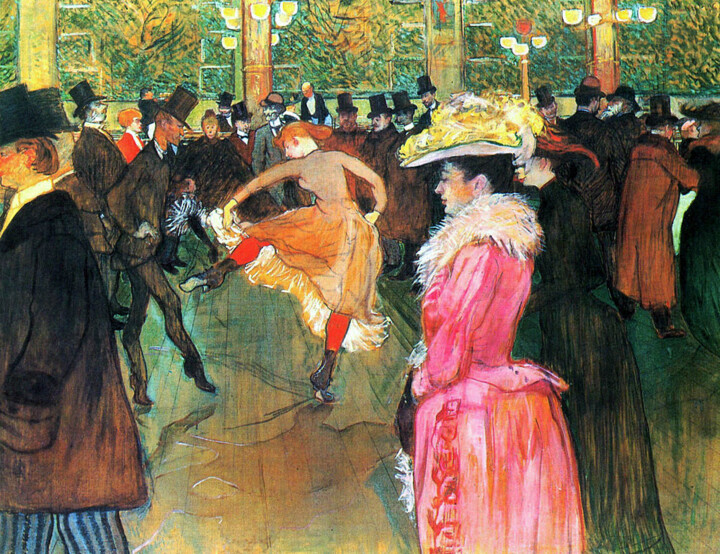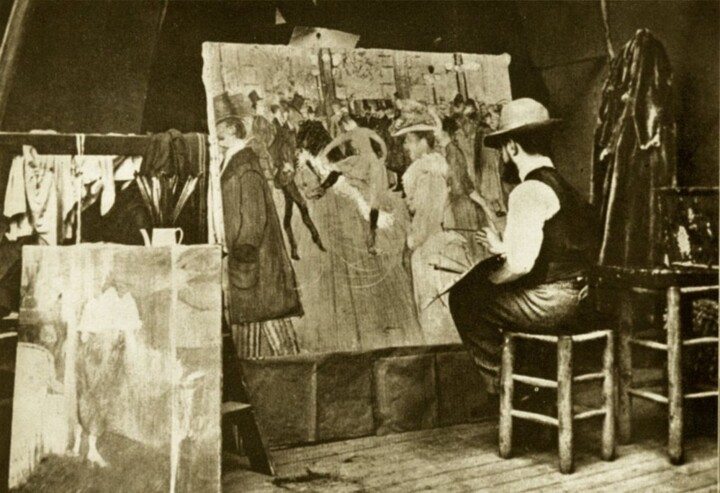 The Moulin-Rouge Dance (1890), oil on canvas (100.5 × 150 cm), Philadelphia, Philadelphia Museum of Art
The Moulin-Rouge Dance (1890), oil on canvas (100.5 × 150 cm), Philadelphia, Philadelphia Museum of Art
Danse at the Moulin-Rouge is an oil on canvas painting by the French artist Henri de Toulouse-Lautrec. It was painted in 1890 and is the second of several graphic paintings by Toulouse-Lautrec depicting the Moulin Rouge cabaret, which opened in Paris in 1889. The painting measures 115 × 150 cm, Lautrec's work is currently on display at the Philadelphia Museum of Art.
The painting shows two people dancing the cancan in the middle of a crowded dance hall. On the back of the painting, an inscription by Toulouse-Lautrec reads: "The instruction of newcomers by Valentin le Desossé". This inscription was found only recently. This means that the man to the left of the dancing woman is a well-known Moulin Rouge dancer, Valentin le Desossé. He teaches the new cabaret dancer. On the right, a mysterious aristocrat dressed in pink. There are also many aristocratic people in the background, like the poet Edward Yeats, the owner of the club and even Toulouse's father.
Henri de Toulouse-Lautrec
Henri de Toulouse-Lautrec was born in Albi, France, into a wealthy family with noble roots. His ancestors were the Counts of Toulouse. His parents' cousins are probably the cause of the genetic disease he discovered when he was 10 years old. His bones were weak and broke easily, and he was not growing well. He was only 1.52 meters tall. Although his face is also distorted, Lautrec is a cheerful and sociable person who likes to joke about his appearance. Lautrec became an artist at the age of 20. His uncle helps him get started. In 1884 he moved to Paris, where he lived in the bohemian district of Montmartre. Lautrec learned to paint in the studios of other artists and met people of his own age, like Van Gogh. He wrote for magazines and worked in the field of posters, which was booming at the time.
Lautrec likes to go out at night and get drunk. He goes to the Moulin-Rouge, opened in 1889, where La Goulue, Jane Avril and Valentin le Désossé perform. He also produced posters for the reopening of the Japanese Divan, where Yvette Guibert sings. Lautrec shows the actors and actresses of the entertainment world with a touch of irony. He does not hesitate to make fun of their faces, even if it means bordering on caricature. More than any other illustrator, Lautrec gave the artists of Montmartre their own graphic style.
 Toulouse-Lautrec painting La Danse au Moulin-Rouge in 1890
Toulouse-Lautrec painting La Danse au Moulin-Rouge in 1890
Lautrec only frequents prostitutes because his body is difficult and almost deformed. He did not feel judged and did not judge these women, who were considered bad people. In the 1890s, the world of brothels became one of his favorite subjects, but he could not freely exhibit his works, which were considered too scandalous. Lautrec contracted syphilis, which, combined with his alcohol consumption, caused him to die young, at the age of 36, in 1901.
Toulouse Lautrec and the cabaret
Toulouse-Lautrec made famous Montmartre, its painters, its daughters, its original characters and its unbridled parties at the end of the 19th century. The history of Parisian cafés, concerts, cabarets and balls which made the Butte a place of celebration and fun remains closely linked to the celebrity of the artist. He didn't care what people said about him. And his nonconformist life, different from the rules of his time, takes place in places that have become legendary.
He spent a lot of time in cabarets and theaters and lived most of his life in Montmartre, north of Paris. The strange world he lived in was a natural subject for his paintings.
This work shows a dance scene at the Moulin Rouge and the atmosphere of the cabaret, with men and women walking loudly and constantly on the large ballroom stage, which occupied most of the cabaret at the time. Most of the characters are men in dark three-piece suits, but there are a few women in the image, such as a woman in pink in the foreground and a dancer in the middle. The scene takes place at the Moulin Rouge, one of the most popular cabarets of the time.
Table details
The man in black
 The man in black on the left of the painting is Valentin le Desossé, or Edme-Étienne-Jules Renaudin, a famous dancer and contortionist of the time who danced with La Goulue. He is tall and has bow legs. He is dressed in black and wears a top hat, very fashionable at the time. He teaches a young red-haired woman to dance. She wears a beige dress, white petticoats and red stockings. We see her calves and the heeled boots she needs to dance the chahut-cancan, which is the dance that preceded the French cancan.
The man in black on the left of the painting is Valentin le Desossé, or Edme-Étienne-Jules Renaudin, a famous dancer and contortionist of the time who danced with La Goulue. He is tall and has bow legs. He is dressed in black and wears a top hat, very fashionable at the time. He teaches a young red-haired woman to dance. She wears a beige dress, white petticoats and red stockings. We see her calves and the heeled boots she needs to dance the chahut-cancan, which is the dance that preceded the French cancan.
The Bourgeois Woman

A bourgeois woman stands next to the dancer. She wears a pink satin dress with white fur, a large feathered hat and black gloves. Her straight and haughty body contrasts with that of the dancer, all in curves and in movement. His presence is strange in a cabaret, which is a place where you have fun, but also where you behave badly. This shows that the cabaret is a place where people from different backgrounds can meet.
In the background

We see a crowd of people dressed in the style of the 1890s. The men wear three-piece suits and top hats or bowler hats.
The woman dressed in black

The woman in black in the foreground would be Jane Avril, a famous Moulin Rouge dancer.
The man with white hair on the face

The white-bearded man near the bar on the right is believed to be Toulouse-Lautrec's father


 Nicolas Sarazin
Nicolas Sarazin





